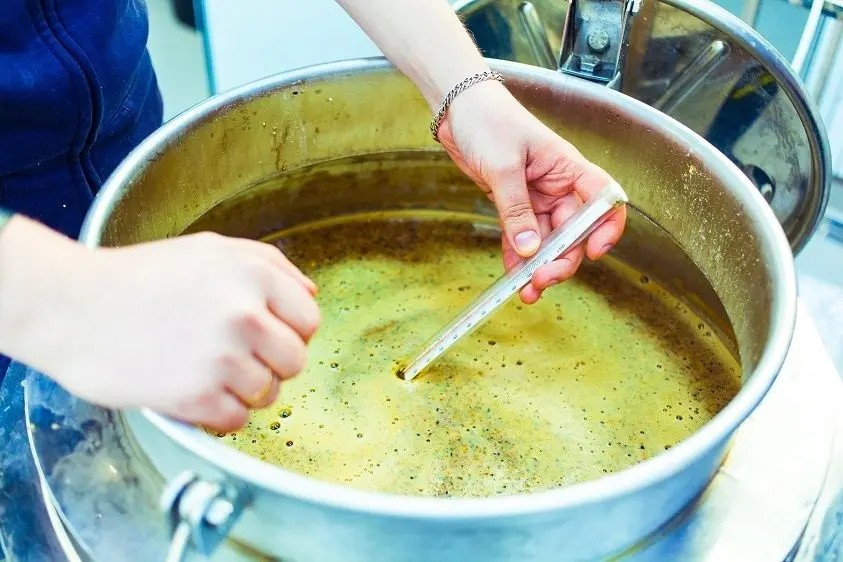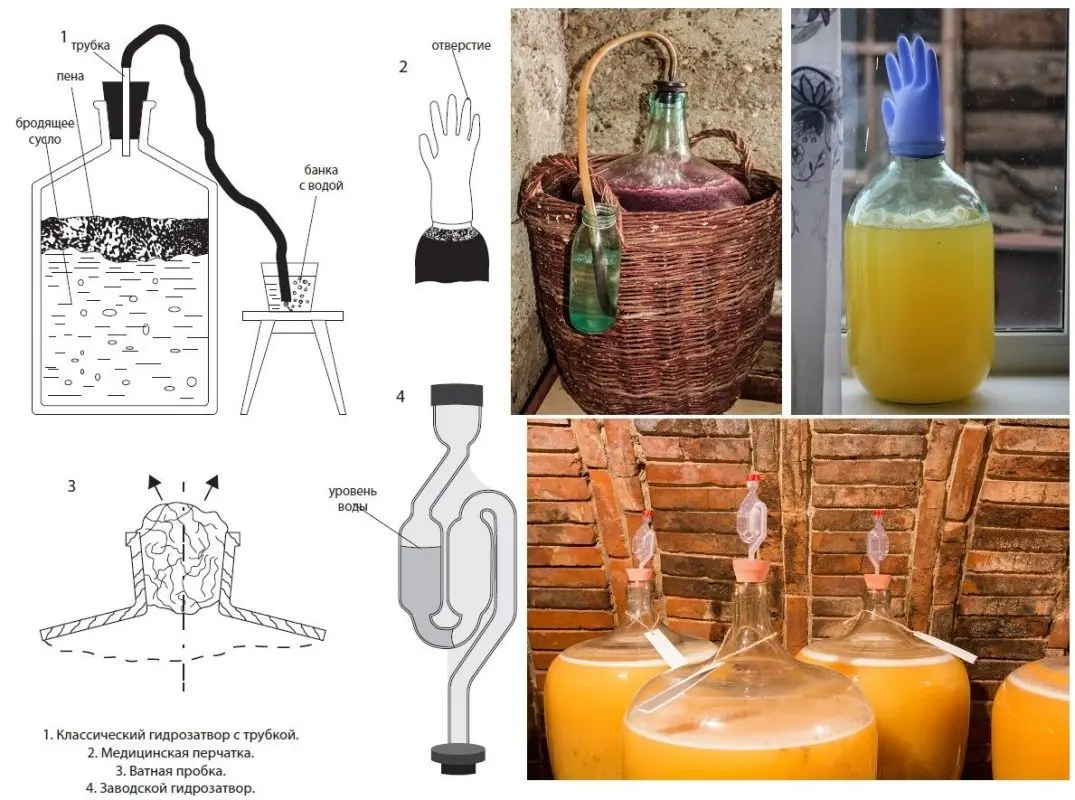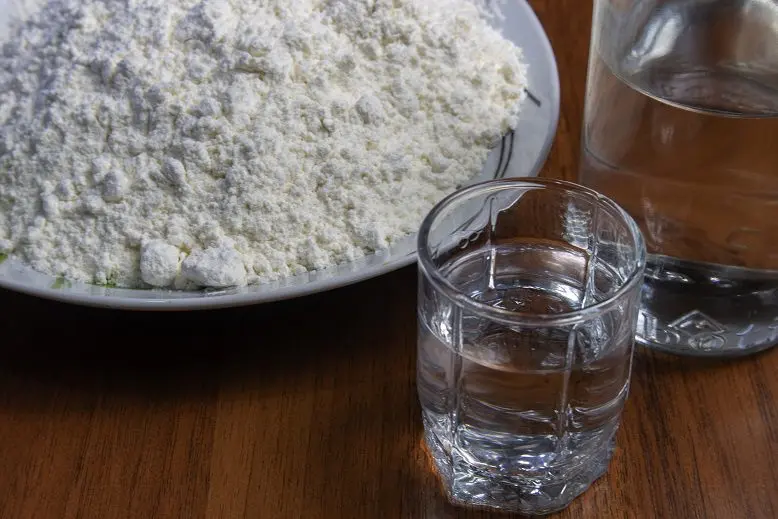Contents
Moonshine from flour is popular among experienced distillers due to the availability of raw materials and the good organoleptic properties of the drink, but for beginner moonshiners, working with flour causes difficulties due to the specific technology of making mash. In this article, we will take a closer look at two basic ways to make mash from flour: malt and synthetic enzymes. Each of them has its own advantages and disadvantages.
Theory
Yeast converts only sugar into alcohol, and flour contains starch, which must be converted into sugar before fermentation, in the language of distillers, saccharification is done. There are two ways of saccharification: hot (GOS) and cold (HOS). The first (hot) – with the help of malt (sprouted grain). The second (cold) – enzymes Amylosubtilin (Amylo-Lux-A) and Glucavamorin (Gluco-Lux-A).
The method does not affect the aroma and taste of moonshine from flour, any will do. Saccharification with malt is considered a classic grain mash, for example, this is how whiskey is made. But this method requires long-term cooking of flour and strict adherence to the temperature regime. The use of enzymes is a relatively new approach that is used to produce alcohol. Enzymes are not heated, but fermentation lasts up to 4 weeks (after hot saccharification – up to 12 days), there is a risk of souring the mash, therefore, an antibiotic and preferably an antifoam agent are added for reinsurance.
Flour selection
Any flour is suitable, even expired. The grade does not matter, the first and second are cheaper than the highest, therefore it is used more often. The yield of moonshine depends on the starch content in the flour. 1 kg of starch gives up to 1,4 liters of distillate with a strength of 40% vol., but in practice, losses during saccharification and distillation must be taken into account, so the real yield will be 10-15% lower.
The easiest to work with and with a good yield is wheat flour, it produces soft and moderately fragrant moonshine. Braga from rye flour foams a lot, the yield is less, and the drink is fragrant, but a little sharp. Moonshine made from cornmeal is a cross between wheat and rye.
Recipe for mash from flour with malt
You can take any store-bought or homemade necessarily unfermented malt (both white and green): barley, rye, wheat, etc. It is considered undesirable to saccharify flour with malt from the same cereal, it is better to combine it. For example, for wheat flour, use barley malt. The optimal ratio is 4:1 (4 parts flour to 1 part malt).
Ingredients:
- flour – 4 kg;
- malt – 1 kg;
- water – 19 l;
- yeast – 50 g dry or 250 g pressed.
Attention! It is very important to adhere to the temperature regimes indicated in the recipe. Without this, successful saccharification is impossible.
Preparation
1. Pour the flour into a cooking container – a saucepan or a bucket. Separately, heat 20 liters of water to 50 ° C (4 liters per 1 kg of raw materials – flour plus malt).
2. Pour water into the flour in a thin stream, stirring constantly. A mass of homogeneous consistency without lumps should form.
3. Heat the wort to 55-60°C, maintain the indicated temperature for 15 minutes, then increase to 62-64°C and hold for 15 minutes.
4. Bring the mixture to a boil and cook for 90 minutes, stirring occasionally so that the porridge does not burn near the bottom.
5. Cool completely homogeneous porridge to 65 °C. While the wort is cooling, grind the malt: the finer the grind, the better. Heat 3 liters of water to 26-28 °C (malt-water ratio 1:3). Add water to malt, stir. You will get “malt milk”, which must be used within 24 hours.
6. Pour the malt milk in a thin stream into the wort that has cooled to 65 ° C while stirring. Cover with a lid and raise the temperature to 63°C. For the next 120 minutes, keep the temperature of the porridge in the range of 55-65 °C. It is important not to overheat above 70 °C, otherwise the malt enzymes will “cook” and saccharification will stop forever. At the end of the process, the wort should be sweet as the starch will turn into sugar.

7. To minimize the risk of pathogen contamination, cool the porridge to 28 °C as soon as possible, for example by placing the container in a cold water or ice bath.
8. Pour the cooled wort into the fermentation tank, filling it to a maximum of 75% of the volume, as space is required for the foam. Add yeast diluted according to package instructions. Install a water seal of any design (you can use a medical glove with a pierced hole in one of the fingers).
9. Transfer the mash from flour to a dark place (or cover) with a temperature of 20-28 ° C. Leave until the end of fermentation (lasts 4-12 days). Braga ready for distillation does not release gas from the water seal (the glove is blown off), it does not taste sweet, it is lighter than the initial one with sediment at the bottom.

Recipe for flour mash with enzymes
Ingredients:
- flour – 5 kg;
- water – 18 liters;
- Amylosubtilin – according to the instructions on the package;
- Glukavamorin – according to the instructions on the package;
- yeast – 50 g dry or 250 g pressed.
- antibiotic (Doxycycline or Amoxicillin) – 100 mg per 20 liters of wort (optional);
- defoamer for mash – according to the instructions on the package (optional).
Enzymes Amilosubtilin (Amylo-Lux-A) and Glukavamorin (Gluco-Lux-A) can be bought in special shops for moonshiners, they are sold in powder or suspension form. Amylosubtilin makes the wort liquid, and Glukavamorin is directly responsible for saccharification, they must be used together. The proportions are indicated in the instructions for the enzymes.
The antibiotic will prevent contamination of the wort by third-party bacteria, and during distillation it does not get into the distillate, so the antibiotics in the mash are not harmful to health. Defoamer is desirable, but not required, it is enough to leave more free space in the container.
Preparation
1. Dilute the antibiotic in water for mash at room temperature.
2. Prepare the enzymes Amylosubtilin and Glucavamorin according to the instructions.
3. Pour flour into water, mix until smooth, so that no lumps remain. You can use a drill with a nozzle for concrete.
4. Incorporate activated yeast into the mash. Add defoamer.
5. Close the fermentation tank with a water seal. Transfer to a dark room with a temperature of 20-28 ° C. Leave until the end of fermentation (lasts 15-28 days). It is advisable to stir the flour mash on enzymes every 8-12 hours, especially if antibiotics were not added.
Obtaining moonshine from flour (distillation)
The technology is designed for a standard distiller.
1. If there is no steam generator, drain the fermented mash from the sediment and filter through several layers of gauze. Remaining flour can burn when heated, ruining the moonshine.
2. Distill flour mash for the first time at maximum speed. Collect distillate until the strength in the stream drops below 15%.
3. Measure the strength of the resulting product. Calculate the amount of pure (absolute) alcohol: multiply the strength in degrees by the volume in liters and divide by 100.
4. Dilute the distillate with water up to 18-20% vol. and do a second run. Collect the first 12-15% of pure alcohol separately. This harmful fraction with a bad smell is called “heads”, drinking it is dangerous for health.
5. Select the main product (called “body”) until the strength in the jet falls below 40-45% (not burning). Then you can stop the distillation or collect the “tails” separately, so that you can then pour it into a new batch of mash before distillation.
6. Dilute the resulting moonshine from flour to a drinking strength (40-45% vol.), Pour into glass bottles for storage, close tightly. Leave for 2-3 days in a dark place to stabilize the taste after mixing with water.










